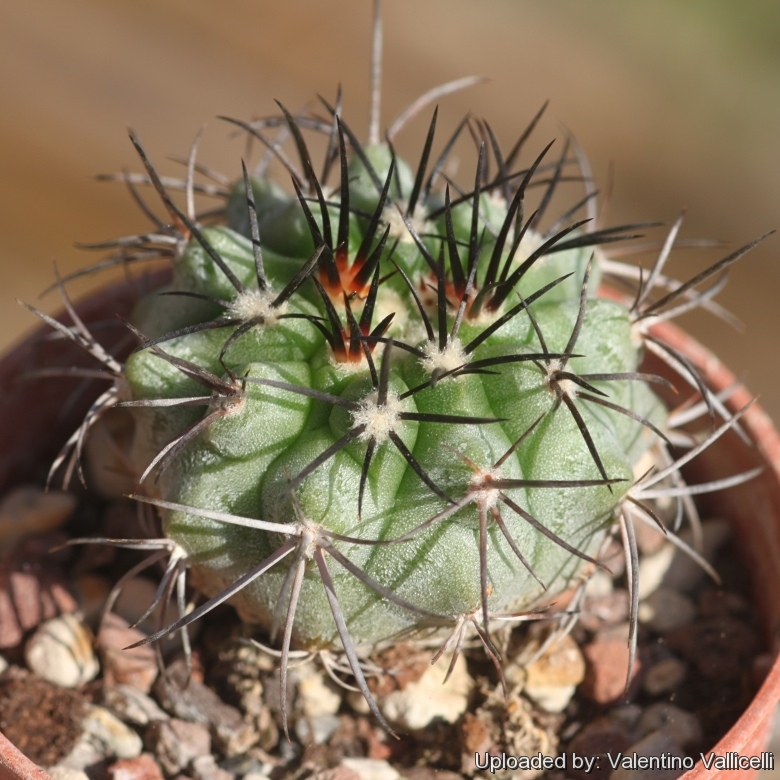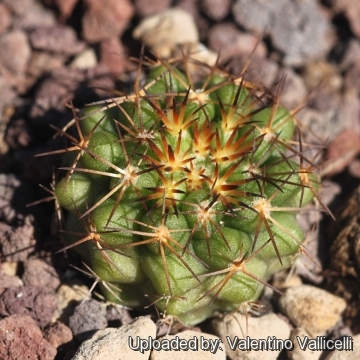
Copiapoa cinerascens Photo by: Valentino Vallicelli
Origin and Habitat: Pan de Azucar National Park on the edge of the Atacama region (south of Barquito, Atacama, north to Taltal, Antofagasta), Northern Chile.
Habitat: Copiapoa cinerascensSN|1420]]SN|1420]] grows in arid coastal plain and low hills amid a cacti rich vegetation on sandy mineral soil covered by ochre stones. It is found below the fog bank, that intercept rainwater runoff from the slopes above. Here occur such plants as tall branched Eulychnia brevifloraSN|7528]]SN|7528]], Argylia radiata, and Skytanthus acutus. In seasons of good rainfall the desert is covered in a rich display of colourful annuals and geophytes. Cinerascens forms large clumps remarkably similar to those of Copipoa serpentisulcata which grow alongside the same beach but the two do not give rise to hybrids.
Synonyms:
See all synonyms of Copiapoa cinerascens
back
Accepted name in llifle Database:Copiapoa cinerascens Britton & RoseCactaceae (Britton & Rose) 3: 88. 1922Synonymy: 14
back
Common Names include:
SPANISH (Español): Erizo Gris
Description: Copiapoa cinerascensSN|1420]]SN|1420]] is one of the most admired species of Copiapoa that forms dense cushions, with many heads covered with greyish wax.
Habit: Slow to cluster, may for many years be a single stem.
Root: Large swollen tap-root connected to the stem-base by a narrow neck.
Stem: Depressed-spherical 8-15 cm in diameter, light grey-green to ash-grey and with grey wool at the apex. The grey coloration is a waxy coating presumably produced to prevent desiccation in it's extremely dry environment. In cultivation the waxy bloom is often not produced, revealing a green epidermis.
Ribs: 15-20 or more , obtuse, with broad low tubercles above the areoles.
Areoles: Crowded, the adjoining ones usually touching, round, 5-8 mm in diameter and, 3-7 mm apart. Young areoles filled with soft grey or black felted wool.
Central spines: 1-4 (usually 2), 1-2 cm long, subulate stout, straight or slightly curved, dark coloured, becoming grey or whitish.
Radial spines: 7-9, 5-15 mm, stoutly needle-like, straight, spreading, interlacing, and never all adpressed, lower ones longest.
Flowers: Diurnal closing at night, protracting the period of opening many days, somewhat fragrant, funnel-shaped, opening widely, yellow, 2,7-5,5 cm long.
Fruit: 1-1,5 cm in diameter, reddish or greenish,
Blooming season: Summer, it needs a lot of sunlight to bloom, so it's pretty rare to have blossoms when in cultivation in greenhouses. It is not unusual for this Copiapoa to take 10 or more years before it starts blooming, but once it does, it should every year.
Seeds: 1,2 x 11 x 8 mm.
Bibliography: Major references and further lectures
1) Edward Anderson “The Cactus family” Timber Press, Incorporated, 2001
2) James Cullen, Sabina G. Knees, H. Suzanne Cubey "The European Garden Flora Flowering Plants: A Manual for the Identification of Plants Cultivated in Europe, Both Out-of-Doors and Under Glass" Cambridge University Press, 11/Aug/2011
3) David R Hunt; Nigel P Taylor; Graham Charles; International Cactaceae Systematics Group. "The New Cactus Lexicon" dh books, 2006
4) N. L. Britton, J. N. Rose “The Cactaceae. Descriptions and Illustrations of Plants of the Cactus Family.” Volume 4, The Carnegie Institution of Washington, Washington 1923
5) Urs Eggli, Leonard E. Newton “Etymological Dictionary of Succulent Plant Names” Birkhäuser 2004.
6) F.Ritter “Kakteen Südamerika” 3: 1072 1980.
7) Graham Charles “Copiapoa” Cirio Pub. Services, 1999
8) Adriana Hoffmann “Cactáceas en la Flora Silvestre de Chile” 1st edition, 1989
9) Gerardo Melcher “El norte de Chile: su gente, desiertos y volcanes” Editorial Universitaria, 01/gen/2004
 Copiapoa cinerascens N. Chanaral. Photo by: Valentino Vallicelli
Copiapoa cinerascens N. Chanaral. Photo by: Valentino VallicelliSend a photo of this plant.The gallery now contains thousands of pictures, however it is possible to do even more. We are, of course, seeking photos of species not yet shown in the gallery but not only that, we are also looking for better pictures than those already present.
Read More... Cultivation and Propagation: Considering that Copiapoa eremophilaSN|1364]]SN|1364]] comes from a habitat with an extremely arid climate, they are remarkably tolerant of pot culture, but susceptible to overwatering. They requires also an appropriate air circulation. Copiapoas are summer grower species easy to cultivate.
Growth rate: This is a slow growing cactus kept for the beauty of its form that will make clumps given the best conditions.
Soils: It likes very coarse mineral cactus mix soil, but can become too elongated if compost is too rich.
Repotting: Use pot with good drainage.
Watering: It requires light but regular waterings in summer, but let the soil mix dry between waterings, but do not overwater (Rot prone), it must be strictly kept dry throughout the winter quiescent period since it is very sensitive to any moisture excesses keep dry in winter.
Fertilization: Feed with a high potassium fertilizer in summer.
Hardiness: Not highly tolerant of a great deal of frost.They need to be kept in a cool place during winter rest and are resistant to light frost if kept on the dry side prior to, and during, cold weather ( they are hardy to -2 C ° C short periods). However some warmth throughout the year will increase the grower's success (minimum 5° to 10°C during rest season).
Exposition: Requires full sun or light shade and careful watering to keep plant compact with strong coloured spines. Tends to bronze in strong light, which encourages flowering and heavy spine production. Light shadow my be useful in the hottest summer days.
Uses: It is an excellent plant for container growing. It always looks good and stays small. It look fine in a cold greenhouse and frame or outdoor in a rockery.
Pests & diseases: It may be attractive to a variety of insects, but plants in good condition should be nearly pest-free, particularly if they are grown in a mineral potting-mix, with good exposure and ventilation. Nonetheless, there are several pests to watch for:
- Red spiders: Red spiders may be effectively rubbed up by watering the infested plants from above.
- Mealy bugs: Mealy bugs occasionally develop aerial into the new growth among the wool with disfiguring results, but the worst types develop underground on the roots and are invisible except by their effects.
- Sciara Flies: Sciara flies are one of the major problems for seedlings. It is a good practice to mulch your seedlings with a layer of grit, which will strongly discourage the flies.
- Scales: Scales are rarely a problem. It is wise to treat your whole collection with a systemic insecticide twice a year in spring and autumn.
- Rot: Rot is only a minor problem with cacti if the plants are watered and “aired” correctly. If they are not, fungicides won't help all that much. To prevent rottenness it is also advisable to surround its root neck by very rough sand or grit, this help a fast water drainage.
Propagation: Seeds (or offsets if available), Grafting is often used to speed growth rate and to create a back-up to plants in collection. Seeds germinate in 7-14 days at 21-27° C in spring, remove gradually the glass cover as soon the plants will be well rooted (ca 1-2 weeks) and keep ventilated, no full sun for young plants!












